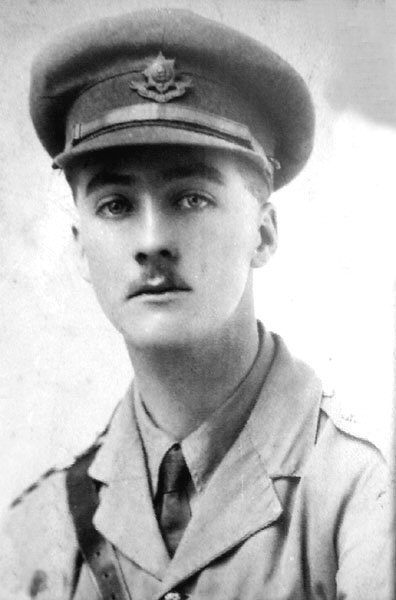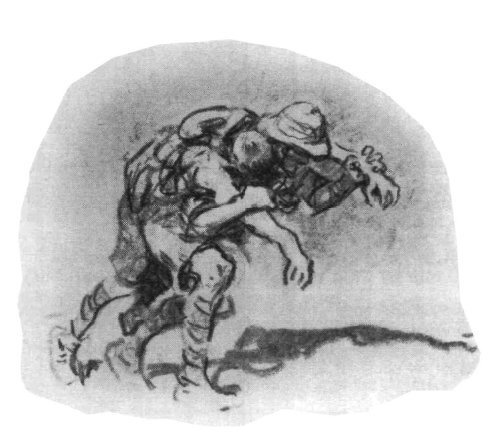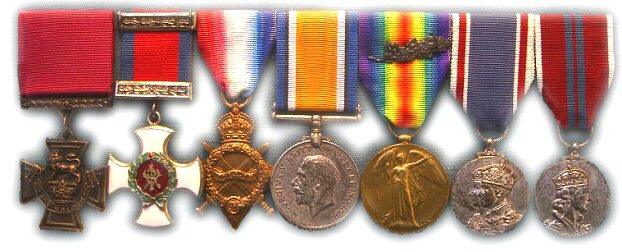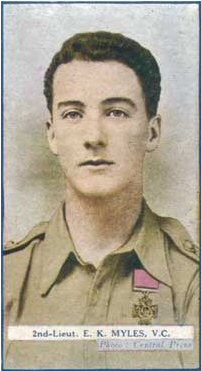2nd Lieutenant Edgar Kinghorn MYLES V.C., D.S.O.
Edgar Kinghorn Myles was born in East Ham, Essex on the 23rd July 1894, son of Andrew Kinghorn Myles, a school teacher, and Agnes Jane Myles (nee Bain). He was educated at Shaftesbury Road School, East Ham and East Ham Secondary School. In January of 1907 he joined the Boys' Brigade as a member of the 17th South Essex (East Ham) Company and was appointed staff sergeant in 1910 a position which he held until 1912 after moving to Wanstead. When war broke out in 1914 he was already employed as a clerk with the Port of London Authority but he gave up that job and joined the Army on the 20th August 1914, as a private soldier (army number 9311) in the 9th Battalion Worcestershire Regiment. He quickly rose to Lance Corporal and was then recommended by the 9th Battalion commander for a commission and appointed a temporary 2nd Lieutenant on the 28th November 1914. He landed with the 9th Battalion on the Gallipoli Peninsula on the 13th July 1915 and was promoted to Lieutenant on the 22nd July and employed as the battalion bombing officer. He was given a regular commission in the Welsh Regiment on the 7th January 1916, but stayed with the 9th Battalion Worcestershire Regiment, as a 2nd Lieutenant but returned to a regular commission with the Worcestershire Regiment with the rank of 2nd Lieutenant and promoted to lieutenant on the 12th January 1917. Lieutenant Edgar Kinghorn Myles was awarded the Victoria Cross for his bravery at Sanna-i-Yat, Mesopotamia, whilst the 9th Battalion were trying to relieve on the 9th April 1916. His citation reads: "Edward Kinghorn Myles, Lieutenant The Welch Regiment for most conspicuous bravery. He went out alone on several occasions in front of our advance trenches, and, under heavy rifle fire and at great personal risk, assisted wounded men lying in the open. On one occasion he carried in a wounded officer to a place of safety under circumstances of great danger." (London Gazette 26th September 1916). Below is an account of the 9th Battalions actions during the second attack on Sanna-i-Yat and how Lieut. Myles won his Victoria Cross. |
Lieutenant Edgar Kinghorn Myles V.C. |
SECOND ATTACK ON SANNA-I-YAT (8th to 9th April 1916)
At 8 0 p.m. on the 8th April 1916 the advance began. Together with the other troops of the 13th Division the 9th Worcestershire marched forward across the Falahiya trenches, some four miles over rough ground to the newly made trenches of the 7th Indian Division. After the moon had set the night was dark and very quiet, with but little firing from either side.
After the inevitable difficulties of a deployment at night, the 13th Division formed up for attack. The Division was disposed with the 38th and 40th Brigades in front and the 39th Brigade behind in support. The two leading Brigades were each extended in four long waves of men. Behind them were formed the supports. The deployment was completed at about 2.0 a.m. The troops lay down and awaited the hour of attack.
In war the physical trials are often more effective than the action oi the enemy. To the heat of the day had succeeded a night of intense cold. The waiting troops suffered severely, and were quite benumbed when, soon after 4.0 a.m. the word was passed down the line to prepare for attack.
It was still quite dark. In silence the long lines of men moved forward. Nearly 400 yards they advanced unchallenged; then came a splutter of fire from the front. Almost immediately a great red flare blazed out on the right front of the advancing troops, lighting up the whole scene. Then a second flare, a great green light, went up on the left. At once a storm of fire was opened. Bullets tore through the ranks and shrapnel burst close overhead.
The leading wave of the attack charged gallantly, reached the enemy's trenches and plunged in; but the second wave in that glare and under that fire wavered, stopped, and then fell back on those in rear. The confused mass herded back, and crashed into the supporting battalions of the 39th Brigade. In a few minutes everything was confusion. The retreating men from the battalions in front had broken into the ranks of the 9th Worcestershire'and 9th Royal Warwickshire and were impeding their advance. Blue flares were now going up all along the enemy's line, and in that baleful glare the mob swayed backwards and forwards in the open, officers and men falling fast under a withering fire. Again and again the officers and men of the 9th Worcestershire made efforts to get forward through the broken ranks of the retreating troops; but the storm of bullets beat down each rush.
Further in front, the brave men of the leading wave were maintaining a most gallant fight in those portions of the enemy's first line which they had won. They were fiercely counter-attacked but held their ground until their bombs and ammunition were exhausted. Then as dawn was breaking they fell back.
Daylight showed the level ground littered everywhere with dead and wounded. The fire from the enemy's trenches forced the survivors to throw themselves prone; they dug in where they lay, working for dear life under a rain of bullets. Eventually a rough line of half-dug cover ran irregularly at a distance of some four hundred yards from the enemy's position. All the battalions of the Division were intermingled, nor was it possible under that close fire to reorganise the units.
Lieutenant Edgar Kinghorn Myles carrying a wounded man to safety |
Between the two firing lines the wounded men everywhere were crying for aid or trying to drag themselves to cover. Many brave efforts were made to assist them. Lieutenant E. K. Myles showed utter fearlessness, dashing out from cover again and again to bring in the wounded. He was hit while carrying a wounded man, but staggered on with his burden and brought him back to safety. His bravery earned him the Victoria Cross. Lieut. E. K. Myles (age 21) was at this date technically an officer of the Welch Regiment, to which he had been gazetted; but he had served throughout with the 9th Worcestershire, and was afterwards transferred to the Regiment. The day slowly wore on, with much heavy firing but no change of position. Eventually darkness closed in, and it was possible at last to count the losses and withdraw the troops. The shrunken platoons and companies assembled behind cover, physically exhausted and bitter at the failure. That failure had been due mainly to the dispiriting effects of the numbing cold; but the previous loss of many of the best officers and N.C.O's. was another contributory cause. In that last attack the loss of officers had been even more severe than in the preceding fights, and when after dark on April 9th, the 9th Worcestershire were relieved, the Battalion marched back under the command of the Quartermaster, Captain C. H. Inwood. Nine officers (d) and over a hundred (29 killed or missing, 79 wounded) of the rank and file had fallen. Casualties were; Killed—2/L.t. B. J. Polack, 2/Lt. A. Dunkley, Lt. M. E. Ball, R.A.M.C. Wounded—Major W. A. S. Edwards (N. Staffs), Captain C. E. Sladden, Capt. P. MacD. Sanderson, Lt. E. K. Myles, 2/Lts. R. C. Marshall, A. H. Davies, R. R. Davies. Major Edwards died of his wounds a few days later. |
After recovering from his wounds Lieut. Myles rejoined the 9th Battalion Worcestershire Regiment on the 20th October 1916.
At a ceremonial parade early November 1916 the Army Commander General Sir Stanley Maude (who sadly died suddenly of cholera a year later) presented the ribbon of the Victoria Cross to Lieutenant Myles for his bravery in the Tigris Campaign.
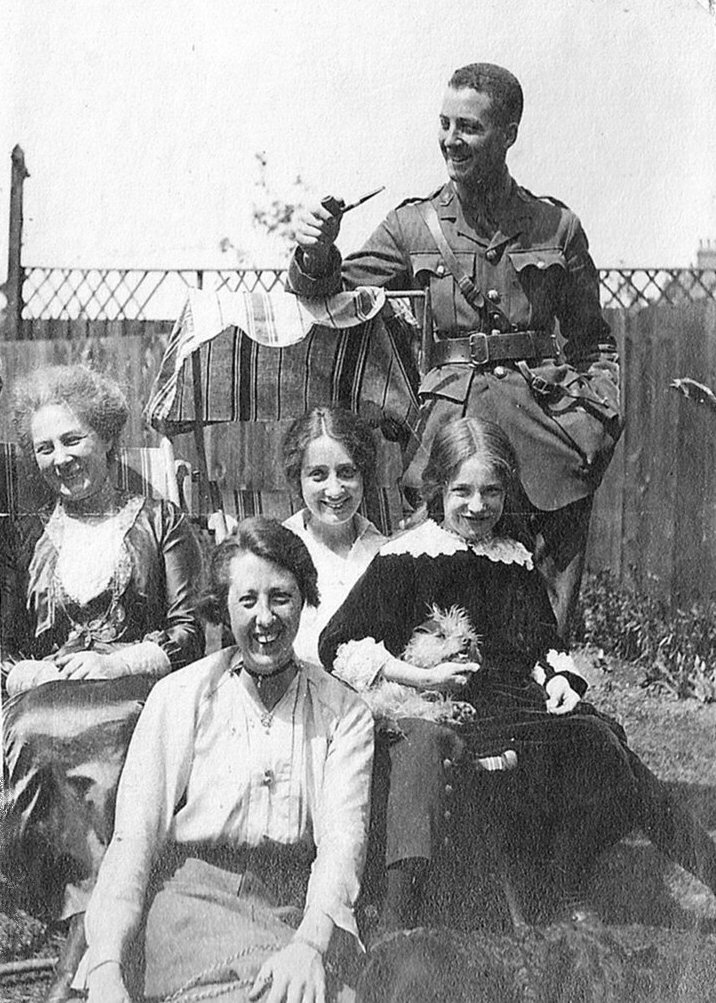
Lieutenant Edgar Kinghorn Myles (right) enjoying sometime with his mother and older sisters
Left to right: Agnes Jane Myles (his mother), Ethel Bain Myles (sister), Edith Winifred Myles (sister), Gladys Hutchison (cousin)
(photo kindly provided by Ian Newson, son of Gladys Hutchison)
Note: Ethel (Effie) married Billy Wilson, Master of the Empire Windrush (steamship) - they had no children. Edith (Winnie) was a school teacher married Walter Myles, (same surname).
On 25th January 1917, still serving with the 9th Battalion at Kut-Al-Amara and acting Captain commanding 'A' Company, whilst wounded he still continued to command his company and direct the defence. For his gallant actions he was created a companion of the Distinguished Service Order.
The Citation for this reads:
"For conspicuous gallantry and devotion to duty. When all the officers except two had become casualties, he, for five hours, inspired confidence in the defence against two counter-attacks and sent back most accurate and valuable reports of the situation. His courage and fine example were largely responsible for the steadiness of all ranks under him." (London Gazette 26th April 1917).
He had already been presented with his D.S.O. by General Maude on the 17th March 1917.
After recovering from his wounds he rejoined the 9th Battalion for active service on the 29th September 1917. A few weeks later he was back in Mesopotamia with the Battalion where he remained until April 1918. During this time he was wounded again twice and at one point sent to India to recover.
He was also mentioned-in-despatches twice (London Gazette dates 19th October 1916 and 15th August 1917).
On the 4th September 1918, Lieutenant Edgar Kinghorn Myles was presented with his Victoria Cross by H.M. King George V at Buckingham Palace.
Edgar Kinghorn Myles V.C. medal group Victoria Cross, Distinguished Service Order, 1915 Star, British War Medal, Victory Medal with mentioned-in-despatches leaf, King George VI Coronation Medal, Queen Elizabeth II Coronation Medal |
Gallahers cigarette card |
After the war Lieut. Myles was employed as a Staff Officer at the War Office. In 1920 he rejoined the 4th Battalion Worcestershire Regiment in Cologne.
During the 1921 coal strike he was stationed at the depot of the Highland Light Infantry at Glasgow and later moved to Ireland.
On the 5th December 1921, he was seconded to the Royal Tank Corps and on the 9th May 1923 transferred to the King's Liverpool Regiment. He was promoted to substantive rank of Captain on the 22nd February 1925.
On the 10th March 1928, Myles retired from the Army.
Captain Myles then worked in the Film business working for Gaumont British Newsreel Productions and worked on short films. During the later part of 1934 he took over the management of a cinema in Bristol (The News Theatre). In 1936 at Elstree Studios he took part in a film about the Irish Rebellion called "Ourselves Alone".
During the early part of the Second World War he served briefly in the Army as a Staff Officer at H.Q. Northern Command (9th April 1939 to 22nd January 1940). On the 23rd July 1945 he was retired from the Regular Army Reserve of Officer as he was too old for futher recall.
At the age of 52, on the 25th March 1947, he married Ellen Marian Carr (formerly Illingworth), by licence, at the Registry Office, Hatfield.

Marriage Certificate of Edgar Kinghorn Myles
After their marraige they lived in Putney, West London but in the late 1950's it seems that Edgar Myles Kinghorn fell on hard times and sold his medals to a dealer. It also appears that he left the family home and was living on his own in a converted railway cattle truck, with two dogs.
The medal dealer who had bought his medals put them up for auction at Messrs. Spinks in November 1960. With the aid of a grant of £200 from the Army Museum Ogilvy Trust and donations from current and ex. officers and men of the Worcestershire Regiment, the Worcestershire Regiment managed to purchase the medals in April 1961 for £675 and today they are on display in the Regimental Museum in Worcester.
in February 1964 and only after one of his dogs had died, was he persuaded by the Worcestershire Regiment and Welsh Regiment to take a place in Huntley Royal British Legion Home, Officers' Association County Home in Bishopsteignton, Devon, where he died on the 31st January 1977, age 82. His funeral took place in Torbay and he was cremated at Torquay Crematorium on the 4th February 1977, with his ashes scattered on the lawn in the Garden of Remembrance. Major A. J. Gutch, M.C. represented the Worcestershire Regiment at the funeral.
His wife Ellen Marian Myles eventually died in 1985 (age 84) at the time she was living in Berkshire.

